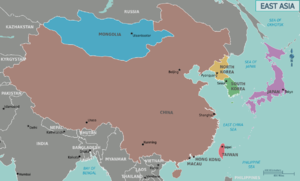
Back تاريخ شرق آسيا Arabic Көнсығыш Азия тарихы Bashkir পূর্ব এশিয়ার ইতিহাস Bengali/Bangla تاریخ شرق آسیا Persian Itä-Aasian historia Finnish Արևելյան Ասիայի պատմություն Armenian 東アジア史 Japanese ភូមិសាស្ត្រនយោបាយដើមបូព៌ា Cambodian 동아시아의 역사 Korean Austrumāzijas vēsture Latvian/Lettish


The history of East Asia generally encompasses the histories of China, Japan, Korea, Mongolia, and Taiwan from prehistoric times to the present.[1] Each of its countries has a different national history, but East Asian Studies scholars maintain that the region is also characterized by a distinct pattern of historical development.[2] This is evident in the relationships among traditional East Asian civilizations, which not only involve the sum total of historical patterns but also a specific set of patterns that has affected all or most of traditional East Asia in successive layers.
- ^ Holcombe, Charles (2017). A history of East Asia: from the origins of civilization to the twenty-first century (2nd ed.). Cambridge University Press. ISBN 978-1-107-11873-7.
- ^ Austin, Gareth (2017). Economic Development and Environmental History in the Anthropocene: Perspectives on Asia and Africa. London: Bloomsbury Publishing. p. 272. ISBN 978-1-4742-6749-6.